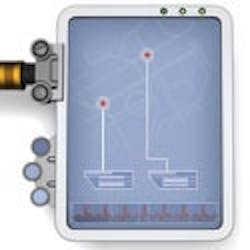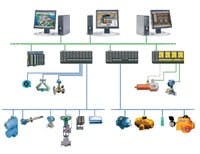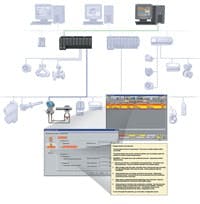Predictive maintenance goes beyond controls with smart instruments
Smart instruments perform calculations locally inside field devices. Self-diagnosis becomes possible, and extends to the entire valve-instrument-controller closed-loop control application. Furthermore, the intelligence extends into the operating equipment as well, via vibration monitors, thermography and other online measurements. Smart diagnostics provide the basis for predictive maintenance, because problematic trends are often seen in the diagnosis long before they become catastrophic. Turnaround schedules can be fine-tuned to focus on equipment that truly needs servicing. The result is a shorter, more organized turnaround and lower overall maintenance costs.
Built on smart instruments
Figure 1. A modern, bus-based control architecture includes smart instruments networked through both the distributed control system (DCS, gray) and safety instrumented system (SIS, yellow).
Figure 1 depicts an example of modern, bus-based, smart instrument, control and safety system architecture. The upper portion shows the microprocessor-based distributed control system (DCS) and safety instrumented system (SIS). The DCS (grey) includes the three groups left and center. The SIS (yellow) is on the right. The lower portion represents the smart instrument network.
The microprocessors in smart instruments monitor a myriad of information about the conditions, status, health and performance of the devices. The control systems, safety systems and asset optimization applications monitor the advanced diagnostic information to initiate appropriate action and notify operators and maintenance staff when a problem is detected.
Asset optimization systems
These systems are layered on top of the smart instruments and manage the configuration, maintenance records, equipment alerts and event history. They often use a Web-based portal to monitor and track performance of instrumentation as well as rotating, fired and electrical equipment. Figure 2 shows a simple example. The diagnostic in this example is “plugged impulse lines detected.”
In the latest systems undergoing beta testing, asset optimization applications connected to computerized maintenance management systems (CMMS) automatically schedule work orders, parts and tasks when smart instruments detect a need to repair themselves.
The power of predictive
Figure 2. Diagnostic messages appear on the operator interface when the smart instrumentation detects anomalies.
Some examples of the advanced diagnostics available from smart instrumentation that detect when maintenance is required are shown in the sidebar, “Problems found”. Predictive maintenance uses diagnostic metrics to determine which items have crossed a maintenance threshold and need to be serviced. Whereas a turnaround based on scheduled maintenance requires pulling and servicing between 30% and 50% of the instrumentation, ARC reports that predictive maintenance can be expected to reduce such unnecessary maintenance by as much as 63%.
Many plants have used smart instrumentation and predictive maintenance strategies to streamline maintenance operations, reduce overtime and optimize turnaround activities. Changing the daily work routines of instrument technicians, control engineers and other maintenance staff based on new technologies can greatly reduce reactive maintenance, overtime call-outs and total maintenance cost. Linking asset-optimization systems with turnaround planning reduces unnecessary maintenance and allows more efficient use of maintenance resources on the highest-priority items.
| These are examples of the kind of problems that smart instrumentation can detect in operating assets. |
|
Valves
|
|
Instruments
|
|
Mechanical equipment
|
|
Process equipment
|
Greg Martin is a senior process control consultant at Emerson Process Management, Austin, Texas. Contact him at [email protected] and (512) 832-3460.


